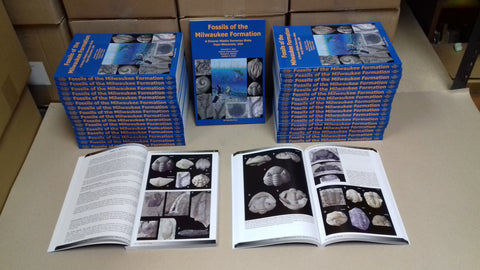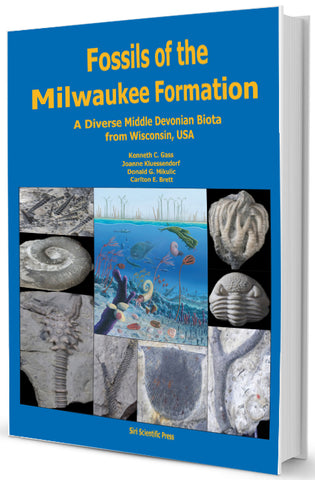Advance copies now available: Fossils of the Milwaukee Formation (Wisconsin, USA)
Posted by David Penney on
The advance copies of FOSSILS OF THE MILWAUKEE FORMATION: A DIVERSE MIDDLE DEVONIAN BIOTA FROM WISCONSIN, USA by Kenneth C. Gass, Joanne Kluessendorf, Donald G. Mikulic and Carlton E. Brett are now available and all pre-publication orders will be shipped over the next few days.



Our 20% discount offer will remain available for one more week only, for those who may have missed it the first time around. Please click the cover image below to go to the product page for more info and to pre-order your copy.
What people are saying
A richly illustrated glimpse of the wonderfully diverse life of the Devonian period, based on a century of collecting, mostly by devoted amateurs. The authors have brought together information from many sources to present a striking snapshot of Milwaukee as it was nearly 400 million years ago.
Richard Fortey, paleontologist, author
This book will make a wonderful identification tool for amateur collectors and is a valuable review of the fossils of the Milwaukee Formation. The images of the trilobites and placoderm dermal plates and fin spines alone will impress anyone who has ever collected in the Milwaukee Formation.
Paul Mayer, The Field Museum
From the back cover
Easily overlooked due to its extremely limited exposure and geographic extent, the Milwaukee Formation seldom comes up in discussions of Devonian paleontology or geology. In spite of this, it contains one of the most rich and diverse Devonian biotas in North America. Fossils of the Milwaukee Formation: A Diverse Middle Devonian Biota from Wisconsin, USA re-examines this virtually forgotten occurrence, compiling all known species, as well as major taxa not previously recorded from this formation, and presents several significant new interpretations. The book covers roughly 250 species from four kingdoms and includes nearly 600 photographs of foraminifers, echinoderms, graptolites, conodonts, a wide range of fishes, a multitude of shelly and encrusting animals, trace fossils, and even terrestrial organisms that washed into the sea. Fossils previously thought to be of forms of brown algae are shown to be, in one case, bark from trees of some of Earth’s first forests, and in another case, a type of terrestrial fungus that may have reached the height of a two-story building.
The authors also use the Milwaukee Formation’s fossils to help illustrate many geological processes and topics in biological science, pointing out that some of those fossils even helped support the theory of punctuated equilibria. The book includes sections on stratigraphy, fossil collecting in the Milwaukee Formation, preparation methods, major collections, and a detailed section on Milwaukee’s cement industry, which was crucial in accumulating the majority of the Milwaukee Formation’s fossils. The book particularly stresses the need for modern analysis of these fossils for their value in what else it may teach us about this biota and what that may add to the body of geologic knowledge. It thus serves as a call to action for researchers by pointing out this need and stating where the major collections are located. A comprehensive glossary is provided for technical terms that are not defined in the text.
Fossils of the Milwaukee Formation will be of interest to fossil enthusiasts, students, professional paleontologists, biologists, academics, as well as historians.
Contents
Introduction
Chapter 1 ─ Cementing its Place in History
Chapter 2 ─ Stratigraphy
Geology, Paleoenvironment, and Paleobiology
Thiensville Formation
Milwaukee Formation
Antrim Shale
Chapter 3 ─ Life in Devonian Milwaukee
Paleoenvironments
Water Depth
Light Intensity
Salinity
Substrates and Sedimentation
Environmental Energy
Modes of Life of Devonian Organisms and Community Paleoecology
Brachiopod Life Modes
Bryozoan Life Modes
Echinoderm Life Modes
Mollusk Life Modes
Arthropod Life Modes
Infaunal Life Modes
Nektonic Life Modes
Planktonic Life Modes
Terrestrial Life Modes
Organism Interactions
Chapter 4 ─ Taphonomy
Skeletal Minerals and Preservation
Calcite and Aragonite
Apatite
Chitin and Other Organic Materials
Modes of Alteration of Skeletons
Permineralization
Replacement
Carbonization
Internal / External Molds
Cavity Formation and Geodization
Preservation of Color Patterns
Trace Fossils
Life and Death Assemblages
Quality of Preservation
Chapter 5 ─ Foraminifers, Ostracods, and Other Microorganisms
Foraminifers
Ostracods
Chapter 6 ─ Conulariids
Chapter 7 ─ Rugose Corals
Chapter 8 ─ Tabulate Corals
Chapter 9 ─ Tentaculitoids
Tentaculitida
Microconchida
Cornulitida
Chapter 10 ─ Bryozoans
Chapter 11 ─ Hederelloids
Chapter 12 ─ Brachiopods
Linguliformea
Craniiformea
Rhynchonelliformea
Chapter 13 ─ Hyoliths
Chapter 14 ─ Mollusks
Gastropoda
Rostroconchia
Bivalvia
Cephalopoda
Chapter 15 ─ Annelid Worms
Polychaeta
Chapter 16 ─ Arthropods
Trilobita
Phyllocarida
Chapter 17 ─ Crinoids, Blastoids, and Edrioasteroids
Crinozoa
Crinoidea
Blastozoa
Blastoidea
Echinozoa
Edrioasteroidea
Chapter 18 ─ Dendroid Graptolites
Chapter 19 ─ Conodonts
Chapter 20 ─ Fishes
Placodermi
Arthrodiriformes
Ptyctodontiformes
Rheaniformes
Petalichthyiformes
Chondrichthyes
Acanthodii
Osteichthyes
Sarcopterygii
Chapter 21 ─ Fungi
Chapter 22 ─ Land Plants
Cladoxylopsids
Lycopods
Chapter 23 ─ Trace Fossils
Chapter 24 ─ Unidentified Body Fossils
Chapter 25 ─ Fossil Collecting in the Milwaukee Formation
Chapter 26 ─ Preparation Methods
Chapter 27 ─ Major Collections
Increase A. Lapham
Thomas A. Greene
Charles E. Monroe
Edgar E. Teller
Gilbert O. Raasch
Chapter 28 ─ The Cement that Made Milwaukee Famous
Stone for Construction
Natural Cement
Geology and Mineral Resources
The Origins of the Milwaukee Cement Industry
The Milwaukee Cement Company
Competition
The End of the Industry
The Quarry Sites After the Close of the Industry
Bibliography
Glossary
Index to the Species, Subspecies, Unnamed Species, and Ichnospecies Cited in the Text
Share this post
- 0 comment
- Tags: Advance copies, New release, News, Special offer
0 comment

